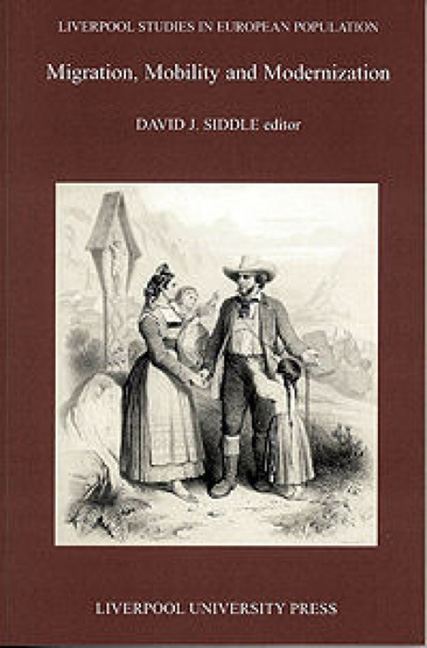Book contents
- Frontmatter
- Contents
- List of Figures
- List of Tables
- 1 Introduction
- 2 Nephews, Dowries, Sons and Mothers: the Geography of Farm and Marital Transactions in Eastern Ireland, c. 1820–c.1970
- 3 Mobility, Kinship and Commerce in the Alps, 1500–1800
- 4 People from the Pits: the Origins of Colliers in Eighteenth-Century South-West Lancashire
- 5 Motives to Move: Reconstructing Individual Migration Histories in early Eighteenth-Century Liverpool
- 6 Urban Population and Female Labour: the Fortunes of Women Workers in Rheims before the Industrial Revolution
- 7 Mobility Among Women in Nineteenth-Century Dublin
- 8 Tramping Artisans in Nineteenth-Century Vienna
- 9 Migration and Urbanization in North-West England: a Reassessment of the Role of Towns in the Migration Process
- Index
8 - Tramping Artisans in Nineteenth-Century Vienna
- Frontmatter
- Contents
- List of Figures
- List of Tables
- 1 Introduction
- 2 Nephews, Dowries, Sons and Mothers: the Geography of Farm and Marital Transactions in Eastern Ireland, c. 1820–c.1970
- 3 Mobility, Kinship and Commerce in the Alps, 1500–1800
- 4 People from the Pits: the Origins of Colliers in Eighteenth-Century South-West Lancashire
- 5 Motives to Move: Reconstructing Individual Migration Histories in early Eighteenth-Century Liverpool
- 6 Urban Population and Female Labour: the Fortunes of Women Workers in Rheims before the Industrial Revolution
- 7 Mobility Among Women in Nineteenth-Century Dublin
- 8 Tramping Artisans in Nineteenth-Century Vienna
- 9 Migration and Urbanization in North-West England: a Reassessment of the Role of Towns in the Migration Process
- Index
Summary
The geographical mobility of artisans in early modern central Europe has become an important theme of social history. Historical research has produced abundant evidence showing the extent of artisanal migratory movements and, in particular, the urban crafts’ dependence upon immigration. The peculiar structures and functions as well as the cultural and institutional frameworks of artisan migration have been widely discussed among historians in the last few decades (Hochstadt, 1983; Jaritz and Müller, 1988). Migration of artisans in the nineteenth century, in contrast to that of the early modern period, has not received the same attention. This is probably due to a change in research perspectives as far as spatial mobility during the Industrial Revolution2 and the ensuing period is concerned. The migrational movements associated with the processes of industrialization and urbanization in the nineteenth and twentieth centuries were subject matter for the emerging social sciences from their very inception, and they continue to occupy the central focus of attention of modern ‘social historical migration research’ (Bade, 1988). Of pre-eminent interest has been migration to the emerging industrial centres and large cities, migrational inter-relationships between large urban centres, as well as overseas emigration (Bade, 1987). With respect to time frame, we notice a strong concentration of research upon the period from about 1880 up to the First World War, which is well documented with source material derived from aggregated governmental statistics (cf Langewiesche, 1977). These sources convey a picture of a ‘spectacular increase’ in migration during the decades prior to the Great War (Langewiesche and Lenger, 1987, p. 91). At the same time, though, it seems to be ‘very unlikely that decisive significance can be attributed to the rise of factory-based production alone as the cause which directly triggered large-scale mobility’ (Lenger, 1986, p. 68). This certainly raises the question of the persistence of traditional forms of migration in industrializing societies and, in particular, of the role of the tramping artisan in the context of industrial and ‘modern’ modes of migration in central Europe.
Some recent studies of journeymen's migration in nineteenth-century central Europe point very clearly to the prevailing importance of this type of geographical mobility during the Industrial Revolution. This relates first and foremost to the sheer volume of mobility.
- Type
- Chapter
- Information
- Migration, Mobility and Modernization , pp. 164 - 185Publisher: Liverpool University PressPrint publication year: 2000

